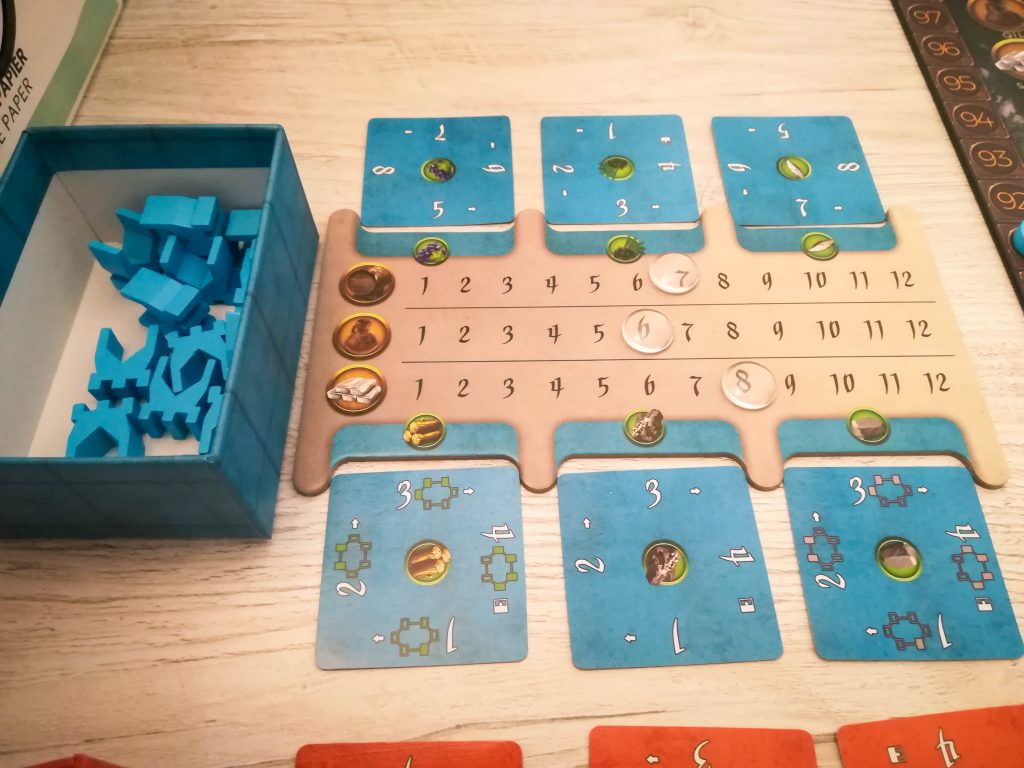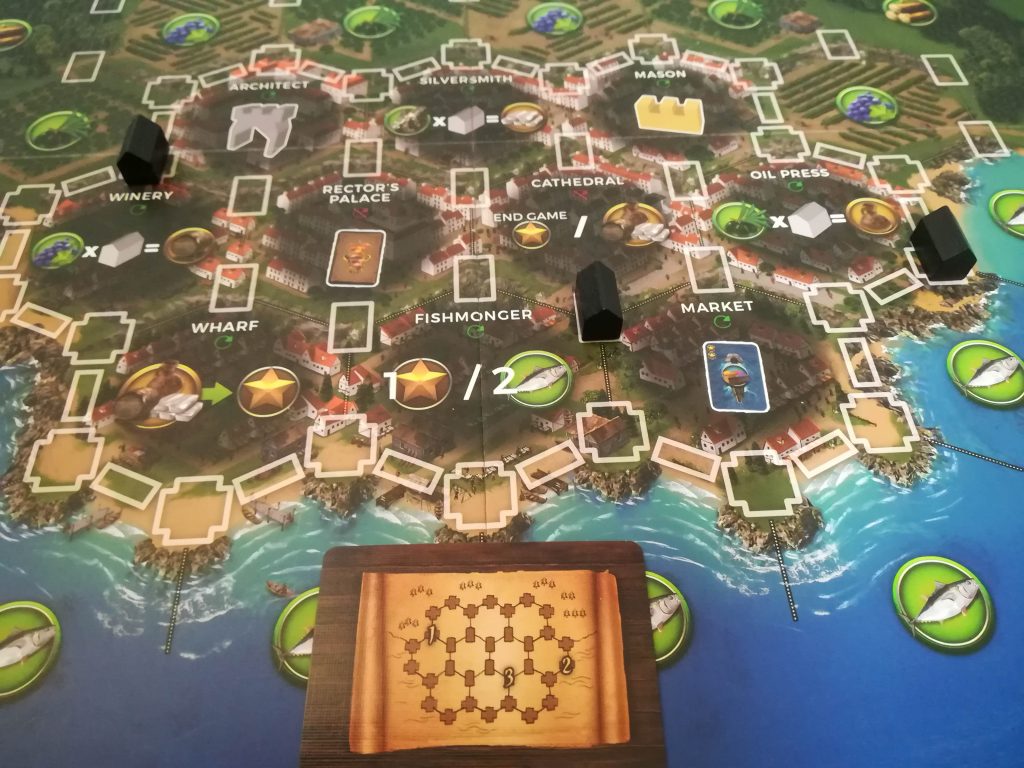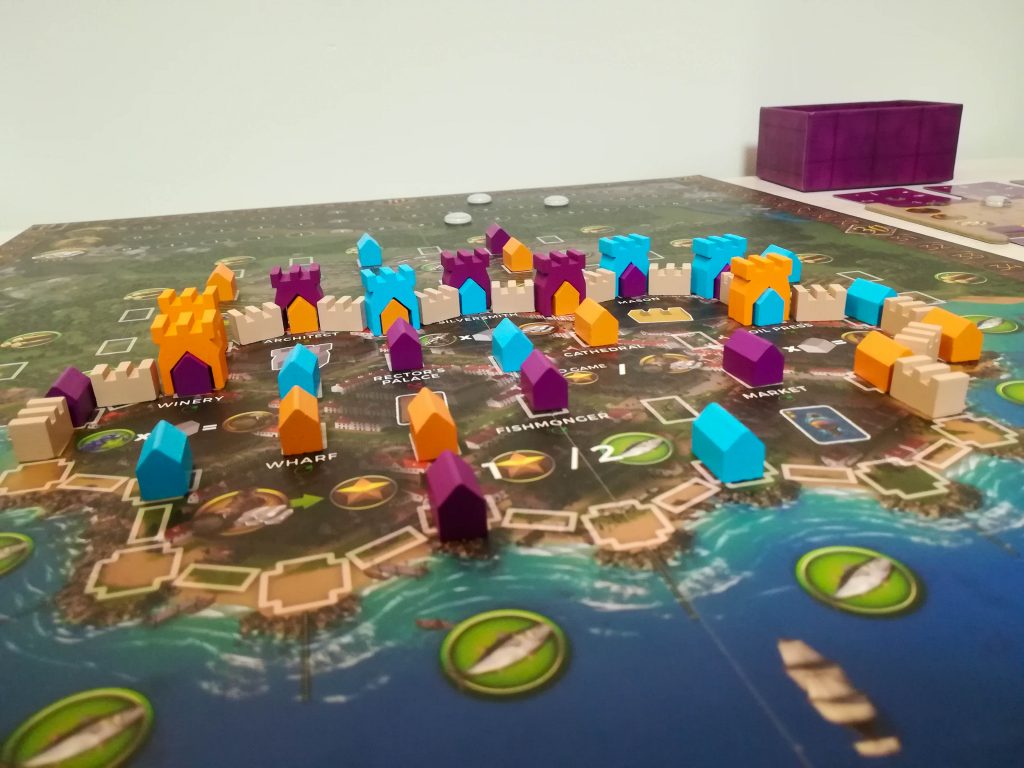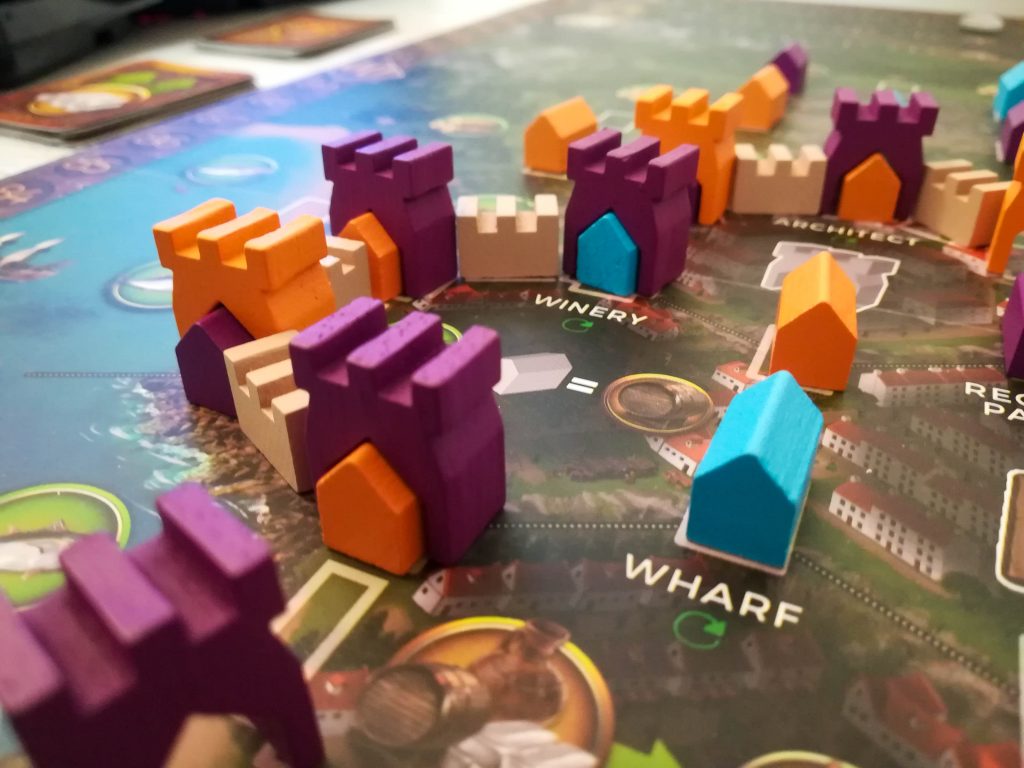Ragusa – Journal Entry #21

In medieval times, Ragusa was an important maritime republic on the coast of the Mediterranean Sea. It served as a gateway between the Easter and Western civilization where merchants from all around the globe would come to sell their goods. Today, the city of Ragusa bears the name of Dubrovnik. Most of the buildings that have been built hundreds of years ago have been well preserved and the old town is a popular destination for tourists.
The board game takes you back to the 15th century, when Ragusa was Venice’s only rival in trading. Your job is to extend the city by building warehouses, towers and other buildings within the city and around it in order for the city to reach the prosperity and wealth that will remain as its legacy.
But how do you play Ragusa?
Players place buildings strategically on the map, gaining access to resources which they can trade for more valuable goods, called commodities. You place these buildings on spaces adjacent to three hexes, all three of which activate a different action. Some of these actions, such as trading at the Wharf, will award you victory points (VPs). Some other actions that can earn you VPs include defending the city by building walls and towers and visiting the Rector’s Palace in order to obtain more objective cards.

There are six resources available on the board: wood, stone, silver ore, grapes, olives and fish. You use the first two to place buildings, while silver ore, grapes and olives can be used for trading. If a players has fish, he can exchange it for other resources at fixed rates. Each player tracks his resources on his own player board using trackers. The player earns these resources by placing his houses on spaces adjacent to hexes on the outside of the city. The resources never deplete, so you can consider them as supply lines. They influence how much of a commodity can be created.
After all players finish placing their buildings on the map, the scoring phase begins. Players gain points for their longest uninterrupted stretch of wall. They earn 1 point for each wall piece, tower and house of their color in this stretch. The Cathedral gives you points for owning sets of commodities on your player board, based on the market price of each commodity. Each ship owned by a player awards him a fixed number of VPs illustrated on the card. In the end, each player gains points for each objective card that he fulfilled (max 12 VPs per card). The player with the most VPs is the winner.
The solo mode
I was intrigued by the solo mode of Ragusa. You play against an AI (the Patrician) that controls two players. To win, your final score has to be higher than both of them (alone, not summed up). At the beginning of the game, each player places 3 houses on the board in the countryside, based on an illustration in the rulebook. This makes sure that both players controlled by the Patrician start with enough resources to be able to correctly place their buildings in the future.

The game revolves around a deck of six randomly drawn Patrician cards that decide the placement of his players’ houses. These cards have marked spots on them where each player will placed his houses in the future. You mark these spots on the board using black houses. The AI will replace them with colored ones whenever his players draw corresponding cards for their spots. As the human player, you can not place your houses on those spots.
This changes the gameplay from what you’re used to when playing against other human players. You know where the AI will place his houses, but you have no idea when these houses will actually be placed. Therefore, you have to plan your actions accordingly and take advantage of the free actions you get whenever the AI places a new house on a hex where you already have one or more houses.
Just like players during a normal game, the AI keeps his bonus cards face down during the game. Because his players gain two bonus cards from the Rector’s Palace instead of one, this adds a new level of adrenaline to the game. I was in constant fear of losing whenever he gained more bonus cards.
About the gameplay
Most of the time, each match will start the same: players will place two or three houses in the countryside to gain access to multiple resources. These will allow you to start placing your houses on spaces adjacent to city tiles (which require stone). After that, players will start focusing more on the actions provided by the city tiles in order to fulfill their objectives and gain VPs. For instance, some players will focus on the market, others will create commodities, while some will try and do a bit of everything.

As the rounds go by, the board gets crowded and the game becomes more and more of an engine. As a result, every house placed will trigger chain reactions that affect many players at the same time. This makes for a lot of player interaction and assures little to no down time between your turns. I enjoy this kind of interaction a lot, as it keeps me constantly focused on the game, looking for opportunities to gain VPs on my opponent’s turn.
I usually try to find optimal strategies for engine building games. However, I did not manage to find an optimal strategy for Ragusa, yet. There are many paths you can follow from start to finish, each one being able to lead you to victory. Still, none of them proved to be more effective than the others. I am a big fan of the market, as it can help you with many objectives and the cards can also score you a lot of points.
What do I think about Ragusa?
Some of the mechanics found in Ragusa will take a bit longer to get used to. On our first game, we forgot to score the wall pieces whenever we placed them, so we ended up with quite low scores. Some players had problems getting used with not spending resources when taking actions, other than trading fish for other resources.
Most of us were used to the classic resource management strategy of gathering as many resources as you can early so that later you can use them to plan your actions better. Since resource management in Ragusa is different than in other games, this strategy was not that useful for us. It turned out that hoarding resources ends with missing out on a lot of free actions. In addition, this does not award you many VPs so it’s far from being efficient.

I enjoyed the strategic decisions you have to take during this game. It is important to place your houses in such a way to take advantage of the other players activating hexes. At the same time, you have to weigh your house placement so that your actions don’t benefit the others more than you! I also enjoyed the randomness provided by the ship cards. It does not affect the gameplay too much and allows for some variability.
Conclusion
In conclusion, Ragusa is a great mix of mechanisms that creates a lot of player interaction and provides a lot of strategic decisions. Fabio Lopiano designed a well balanced game, having multiple paths to victory. I am a big fan of engine building games, two of my favorites being Oh My Goods! and Splendor. After only 5 matches, Ragusa managed to become my favorite engine building game in my collection.
Useful info
Designer: Fabio Lopiano
Publisher: Braincrack Games & Capstone Games
Players: 1-5
Time: 60 min
Times played: 5
Full disclosure: A copy of Ragusa was provided by the game publisher.
Did you like the review? Follow me on my Instagram page where I post daily photos of games I play and other things. You can also support me on Patreon to gain access to various special content, such as game unboxings, first impressions, polls to decide what games to cover next, and early access to reviews!



Great photos and amazing review! You convinced me to add this game to my want-to-play list!